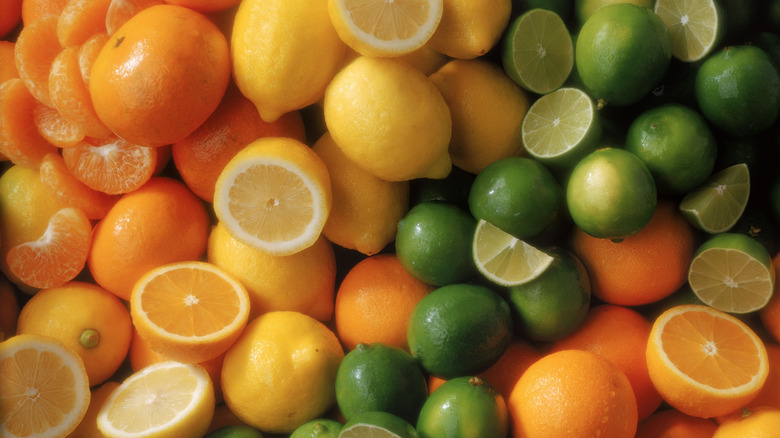Is It Actually Safe To Use Acidic Fruits To Whiten Your Teeth?
If you've been feeling self-conscious about your smile and realize it's time to curb the hourly espressos, you may be searching for smart ways to whiten your teeth. The good news is that as we become more aware of the chemicals in the foods and drinks we consume, a healthy interest in natural remedies is growing.
It's tempting to avoid a trip to the dentist's office by grabbing a box of whitening strips at the drugstore. If you follow the instructions and use them once in a while, they're unlikely to do serious damage. Unfortunately, many people bleach too frequently or leave the strips on the teeth for too long, which can cause weird bright spots, tooth sensitivity, or injury to your gums.
It may surprise you to learn that strawberries and watermelon may in fact lighten teeth. Other safe bets are papaya and pineapple. The proteolytic enzymes found in pineapple and papaya help break down proteins. This protein breakdown is what we want because it aids in diminishing stains and reducing plaque formation. However, not all fruits are created equal when it comes to their whitening potential.
Citric acid-containing fruits should be avoided
What strawberries and watermelon have in common is malic acid, a compound that creates a pleasingly sour taste in some fruits. It also increases saliva production which reduces bacteria in the mouth. Malic acid is known to whiten your teeth and is sometimes used as a toothpaste ingredient.
Until we get the scientific study we deserve on fruit-based tooth whitening, which we imagine is 100 people lounging around eating nothing but papaya, pineapple, strawberries, and watermelon, there won't be definitive proof that these fruits alone will significantly brighten your smile.
On the other hand, citric acid, which is contained in limes, lemons, oranges, and grapefruits, is the enamel-stripping enemy of your teeth, Inland Family Dentistry warns. The low-pH acid also shows up in hard candies, carbonated sodas, and dried fruits. Enamel is the hardest substance in our bodies, and it's there to protect the nerves in our teeth. There's lots of nutritious vitamin C in citrus, but be cautious about your consumption and know that enamel, once stripped, doesn't grow back.
Some brightening alternatives
Your number one priority is good dental hygiene. Brush those puppies twice a day, floss once, and stop gargling with lemonade. Dentists recommend using a soft brush and not scrubbing; light brush strokes will get the job done. Avoid consuming excess amounts of coffee, black tea, red wine, curries, and chewing tobacco, if that's your thing.
If you've got the bucks, you can investigate the effectiveness of an ultraviolet procedure called Zoom to whiten your teeth. Although hydrogen peroxide is often cited as a brightening remedy, too much of it can be harmful, which is why Crest Whitestrips are actually banned in the U.K.
A homemade concoction of equal amounts of stain-lifting baking soda mixed with coconut oil is a gentle, natural remedy, according to Stapleton Dentistry, and the coconut oil has anti-fungal properties. Add a few drops of a high-grade peppermint essential oil — the baking soda will feel a bit bubbly, but the oil creates a more pleasant experience. It's slower to work, but much easier on your teeth.


